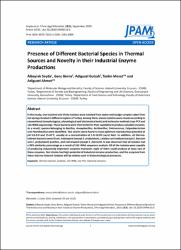| dc.contributor.author | Albayrak, Seyda | |
| dc.contributor.author | Genc, Berna | |
| dc.contributor.author | Ozkan, Hakan | |
| dc.contributor.author | Taskin, Mesut | |
| dc.contributor.author | Adiguzel, Ahmet | |
| dc.date.accessioned | 2019-12-13T05:53:17Z | |
| dc.date.available | 2019-12-13T05:53:17Z | |
| dc.date.issued | 2019 | |
| dc.identifier.citation | Albayrak Seyda, Genc Berna, Ozkan Hakan, Taskin Mesut and Adiguzel Ahmet, Presence of Different Bacterial Species in Thermal Sources and Novelty in Their Industrial Enzyme Productions, J Pure Appl Microbiol., 2019; 13(3):1375-1387. https://doi.org/10.22207/JPAM.13.3.08 | en_US |
| dc.identifier.issn | 0973-7510 | |
| dc.identifier.issn | 2581-690X | |
| dc.identifier.uri | https://doi.org/10.22207/JPAM.13.3.08 | |
| dc.description.abstract | In this study, one hundred and thirty isolates were isolated from water and sludge samples taken from hot springs located in different regions of Turkey. Among them, eleven isolates were chosen according to conventional (morphological, physiological and biochemical tests) and molecular methods (rep-PCR and 16S rRNA sequencing). These bacteria were then tested for their capability to produce valuable enzymes. As a result; species belonging to Bacillus, Anoxybacillus, Aeribacillus, Enterococcus, Exiguobacterium and Paenibacillus were identified. Test strains were found to have optimum reproductive potential at pH 5.0-9.0 and 15-65 degrees C, usually at a concentration of 1.0-10.0% (w/v) NaCl. In addition, all thermotolerant bacteria were Gram, endospore (except E. profundum), catalase and oxidase (except E. faecium and E. profundum) positive, and rod-shaped (except E. faecium). It was observed that all isolates had a 99% similarity percentage as a result of 16S rRNA sequence analysis. All of the isolates were capable of producing industrially important enzymes moreover, eight of them could produce at least two of these enzymes. Test strains had high potential of industrial enzyme production, and the enzymes from these thermo-tolerant isolates will be widely used in biotechnological processes. | en_US |
| dc.description.sponsorship | Ataturk University, TurkeyAtaturk University; Research Development Centre of Ataturk UniversityAtaturk University [FAD-2018-6352] | en_US |
| dc.description.sponsorship | The authors acknowledge the support of Ataturk University, Turkey for this work. This work was supported by the Research Development Centre of Ataturk University (Grant number was FAD-2018-6352). | en_US |
| dc.language.iso | eng | en_US |
| dc.publisher | Dr M N Khan | en_US |
| dc.relation.ispartof | Journal of Pure and Applied Microbiology | en_US |
| dc.rights | Attribution-NonCommercial-NoDerivs 3.0 United States | * |
| dc.rights | info:eu-repo/semantics/openAccess | en_US |
| dc.rights.uri | http://creativecommons.org/licenses/by-nc-nd/3.0/us/ | * |
| dc.subject | Thermo-tolerant | en_US |
| dc.subject | isolation | en_US |
| dc.subject | 16S rRNA | en_US |
| dc.subject | rep-PCR | en_US |
| dc.subject | industrial enzymes | en_US |
| dc.title | Presence of Different Bacterial Species in Thermal Sources and Novelty in Their Industrial Enzyme Productions | en_US |
| dc.type | article | en_US |
| dc.relation.publicationcategory | Makale - Uluslararası Hakemli Dergi - Kurum Öğretim Elemanı | en_US |
| dc.description.wospublicationid | WOS:000488603700008 | en_US |
| dc.description.scopuspublicationid | 2-s2.0-85073052308 | en_US |
| dc.department | Gümüşhane Üniversitesi | en_US |
| dc.authorid | GENC, BERNA / 0000-0002-2790-9578 | |
| dc.authorid | Adiguzel, Ahmet / 0000-0001-8848-6647 | |
| dc.identifier.volume | 13 | en_US |
| dc.identifier.issue | 3 | en_US |
| dc.identifier.startpage | 1375 | en_US |
| dc.identifier.doi | 10.22207/JPAM.13.3.08 | |
| dc.identifier.endpage | 1387 | en_US |
| dc.authorwosid | GENC, BERNA / AAV-9007-2020 | |
| dc.authorwosid | Adiguzel, Ahmet / AAJ-7431-2020 | |
| dc.authorscopusid | 57211229217 | |
| dc.authorscopusid | 56995801400 | |
| dc.authorscopusid | 57211231757 | |
| dc.authorscopusid | 17347046000 | |
| dc.authorscopusid | 6507268431 | |




















